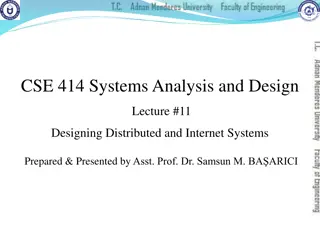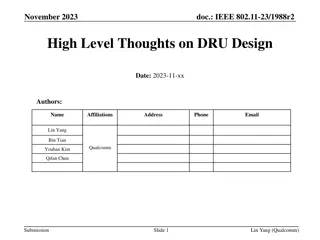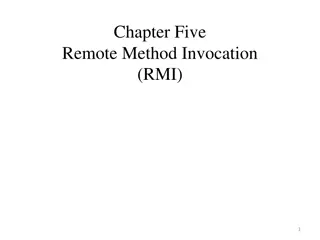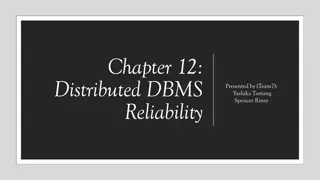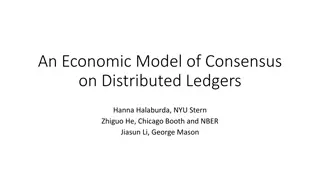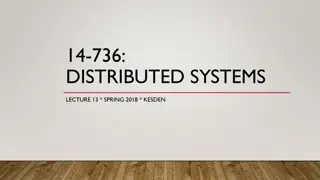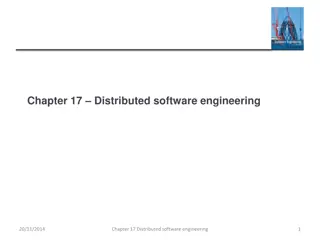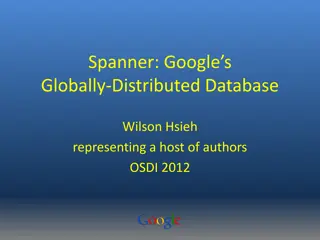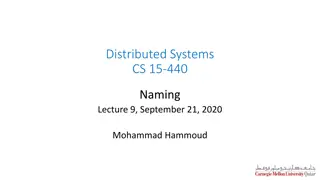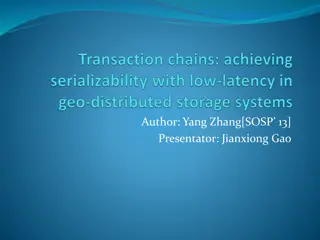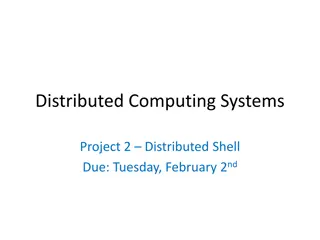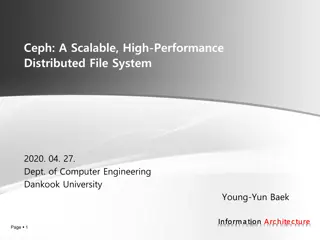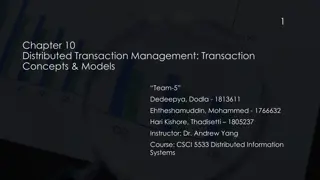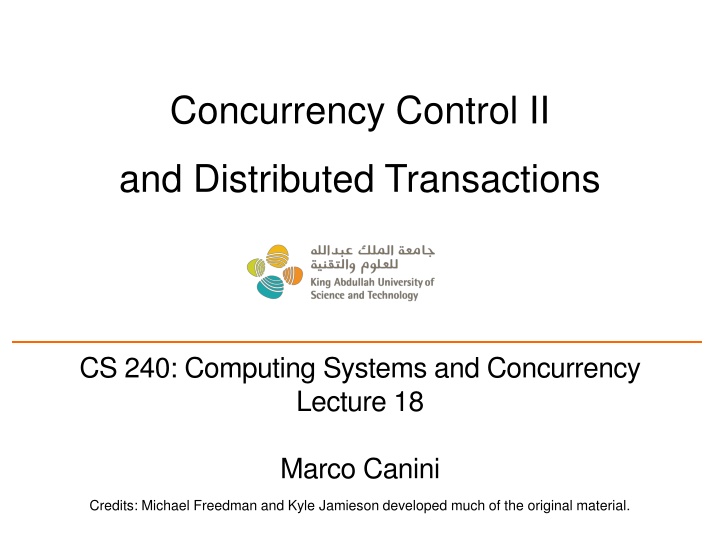
Concurrency Control II and Distributed Transactions in Computing Systems
Learn about serializability, lock-based concurrency control, optimistic concurrency control (OCC), and the three-phase approach in managing transactions over multiple items in computing systems. Explore how OCC minimizes overhead for non-conflicting transactions and ensures system consistency during validation phases.
Download Presentation

Please find below an Image/Link to download the presentation.
The content on the website is provided AS IS for your information and personal use only. It may not be sold, licensed, or shared on other websites without obtaining consent from the author. If you encounter any issues during the download, it is possible that the publisher has removed the file from their server.
You are allowed to download the files provided on this website for personal or commercial use, subject to the condition that they are used lawfully. All files are the property of their respective owners.
The content on the website is provided AS IS for your information and personal use only. It may not be sold, licensed, or shared on other websites without obtaining consent from the author.
E N D
Presentation Transcript
Concurrency Control II and Distributed Transactions CS 240: Computing Systems and Concurrency Lecture 18 Marco Canini Credits: Michael Freedman and Kyle Jamieson developed much of the original material.
Serializability Execution of a set of transactions over multiple items is equivalent to some serial execution of txns 2
Lock-based concurrency control Big Global Lock: Results in a serial transaction schedule at the cost of performance Two-phase locking with finer-grain locks: Growing phase when txn acquires locks Shrinking phase when txn releases locks (typically commit) Allows txn to execute concurrently, improving performance 3
Q: What if access patterns rarely, if ever, conflict? 4
Be optimistic! Goal: Low overhead for non-conflicting txns Assume success! Process transaction as if it would succeed Check for serializability only at commit time If fails, abort transaction Optimistic Concurrency Control (OCC) Higher performance when few conflicts vs. locking Lower performance when many conflicts vs. locking 5
OCC: Three-phase approach Begin: Record timestamp marking the transaction s beginning Modify phase Txn can read values of committed data items Updates only to local copies (versions) of items (in DB cache) Validate phase Commit phase If validates, transaction s updates applied to DB Otherwise, transaction restarted Care must be taken to avoid TOCTTOU issues 6
OCC: Why validation is necessary New txn creates shadow copies of P and Q P and Q s copies at inconsistent state txn coord O txn coord P When commits txn updates, create new versions at some timestamp t Q 7
OCC: Validate Phase Transaction is about to commit. System must ensure: Initial consistency: Versions of accessed objects at start consistent No conflicting concurrency: No other txn has committed an operation at object that conflicts with one of this txn s invocations Consider transaction 1. For all other txns N either committed or in validation phase, one of the following holds: A. N completes commit before 1 starts modify B. 1 starts commit after N completes commit, and ReadSet 1 and WriteSet N are disjoint C. Both ReadSet 1 and WriteSet 1 are disjoint from WriteSet N, and N completes modify phase. When validating 1, first check (A), then (B), then (C). If all fail, validation fails and 1 aborted. 8
2PL & OCC = strict serialization Provides semantics as if only one transaction was running on DB at time, in serial order + Real-time guarantees 2PL: Pessimistically get all the locks first OCC: Optimistically create copies, but then recheck all read + written items before commit 9
Multi-version concurrency control Generalize use of multiple versions of objects 10
Multi-version concurrency control Maintain multiple versions of objects, each with own timestamp. Allocate correct version to reads. Prior example of MVCC: 11
Multi-version concurrency control Maintain multiple versions of objects, each with own timestamp. Allocate correct version to reads. Unlike 2PL/OCC, reads never rejected Occasionally run garbage collection to clean up 12
MVCC Intuition Split transaction into read set and write set All reads execute as if one snapshot All writes execute as if one later snapshot Yields snapshot isolation < serializability 13
Serializability vs. Snapshot isolation Intuition: Bag of marbles: white, black Transactions: T1: Change all white marbles to black marbles T2: Change all black marbles to white marbles Serializability (2PL, OCC) T1 T2 or T2 T1 In either case, bag is either ALL white or ALL black Snapshot isolation (MVCC) T1 T2 or T2 T1 or T1 || T2 Bag is ALL white, ALL black, or white black 14
Consider partitioned data over servers R L U O L R W U P L W U Q Why not just use 2PL? Grab locks over entire read and write set Perform writes Release locks (at commit time) 26
Consider partitioned data over servers R L U O L R W U P L W U Q How do you get serializability? On single machine, single COMMIT op in the WAL In distributed setting, assign global timestamp to txn (at sometime after lock acquisition and before commit) Centralized txn manager Distributed consensus on timestamp (not all ops) 27
Strawman: Consensus per txn group? R L U O L R W U P L W U Q R S Single Lamport clock, consensus per group? Linearizability composes! But doesn t solve concurrent, non-overlapping txn problem 28
Spanner: Googles Globally- Distributed Database OSDI 2012 29
Googles Setting Dozens of zones (datacenters) Per zone, 100-1000s of servers Per server, 100-1000 partitions (tablets) Every tablet replicated for fault-tolerance (e.g., 5x) 30
Scale-out vs. fault tolerance O OO P PP QQQ Every tablet replicated via Paxos (with leader election) So every operation within transactions across tablets actually a replicated operation within Paxos RSM Paxos groups can stretch across datacenters! 31
Disruptive idea: Do clocks really need to be arbitrarily unsynchronized? Can you engineer some max divergence? 32
TrueTime Global wall-clock time with bounded uncertainty TT.now() time earliest latest 2* Consider event enow which invoked tt = TT.new(): Guarantee: tt.earliest <= tabs(enow) <= tt.latest 33
Timestamps and TrueTime Acquired locks Release locks T Pick s > TT.now().latest s Wait until TT.now().earliest > s Commit wait average average 34
Commit Wait and Replication Start Achieve consensus Notify followers consensus Acquired locks Release locks T Pick s Commit wait done 35
Client-driven transactions Client: 1. Issues reads to leader of each tablet group, which acquires read locks and returns most recent data 2. Locally performs writes 3. Chooses coordinator from set of leaders, initiates commit 4. Sends commit message to each leader, include identify of coordinator and buffered writes 5. Waits for commit from coordinator 36
Commit Wait and 2-Phase Commit On commit msg from client, leaders acquire local write locks If non-coordinator: Choose prepare ts > previous local timestamps Log prepare record through Paxos Notify coordinator of prepare timestamp If coordinator: Wait until hear from other participants Choose commit timestamp >= prepare ts, > local ts Logs commit record through Paxos Wait commit-wait period Sends commit timestamp to replicas, other leaders, client All apply at commit timestamp and release locks 37
Commit Wait and 2-Phase Commit Start logging Done logging Acquired locks Release locks TC Committed Notify participants sc Acquired locks Release locks TP1 Release locks Acquired locks TP2 Prepared Send sp Compute sp for each Commit wait done Compute overall sc 38
Example Remove X from friend list Risky post P TC T2 sp= 6 sc= 8 s = 15 Remove myself from X s friend list TP sp= 8 sc= 8 Time <8 8 15 [X] [] My friends My posts X s friends [P] [me] [] 39
Read-only optimizations Given global timestamp, can implement read-only transactions lock-free (snapshot isolation) Step 1: Choose timestamp sread = TT.now.latest() Step 2: Snapshot read (at sread) to each tablet Can be served by any up-to-date replica 40
Disruptive idea: Do clocks really need to be arbitrarily unsynchronized? Can you engineer some max divergence? 41
TrueTime Architecture GPS GPS GPS timemaster timemaster timemaster GPS Atomic-clock timemaster GPS timemaster timemaster Client Datacenter 1 Datacenter 2 Datacenter n Compute reference [earliest, latest] = now 42
TrueTime implementation now = reference now + local-clock offset = reference = 1ms + worst-case local-clock drift + 200 s/sec +6ms time 0sec 30sec 60sec 90sec What about faulty clocks? Bad CPUs 6x more likely in 1 year of empirical data 43
Known unknowns > unknown unknowns Rethink algorithms to reason about uncertainty 44
Next topic: Virtualization and Cloud Computing 45




